Winter Programme 2021-2022
This seasons talks, again, will be, for the foreseeable future, on-line via Zoom. There is a reciprocal arrangement between ourselves - LL&PS Section C - and the Warwickshire Geological Conservation Group - WGCG - to share presentations. Those arranged by WGCG are annotated.
Most presentations are available for Members to view on YouTube; some are restricted for Members only.
Non-members are directed to our Membership page - the Yearly subscription (September - September) is very modest.
Wednesday 15th September 2021
Dr Jonathon Paul (Lecturer in Earth Science at Royal Holloway, University of London )
Subsurface engineering and water resources of Greater London
Stratigraphy, structure, and water have influenced subsurface engineering in London, in particular, the London Underground. The timing of the development, and the spatial form that the tunnels took, have been largely governed by the London Clay, an excellent tunnelling medium. The thickest strata extend as a narrow finger along the axis of the London basin. More minor variations are probably governed by periglacial erosion and faulting. 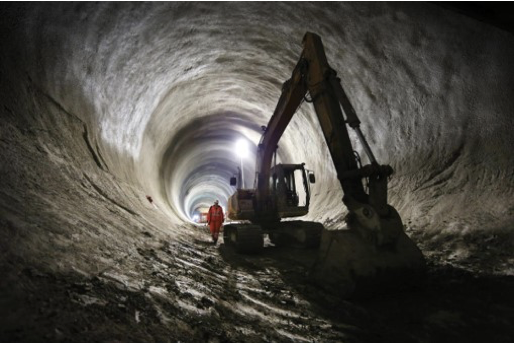
We explore various ‘construction calamities’, and new engineering techniques, that have arisen, as mitigating measures. Some unforeseen geological features have contributed to the ongoing, and widely reported, delays in the opening of Crossrail, and the Battersea Northern Line extension. For example, huge gravel-filled bodies that were formerly underground spheres of ice in Devensian times, (“pingos”). We also explore the way in which the Chalk aquifer continues to shape the exploitation of London's water resources.
Wednesday 29th September 2021
Cindy Howells (National Museum Wales)
Dinosaurs and Deserts in South Wales
Recent discoveries, of new footprints and fossilised dinosaur bones, have increased our understanding of the terrestrial environments and faunas that existed during the Late Triassic and early Jurassic in south Wales. Hot deserts were subject to seasonal flooding events that preserved many footprints of both dinosaurs and other reptiles, in harsh environments where bone material did not fossilise. Subsequent sea-level rise created an island archipelago, where a diverse fauna of small vertebrates, including dinosaurs, lived within a karst landscape which preserved their fossilised bones and teeth in fissure deposits. Theropod dinosaurs are poorly represented from the earliest Jurassic, so the discovery of a partial articulated skeleton will bring better insights into the evolutionary relationships of this group.
Wednesday 27th October 2021
Dr Katie Strang (Scottish Geology Trust)
Celebrating Scotland’s geological heritage with the Scottish Geology Trust
The Scottish Geology Trust was launched in 2020, with the key objective of inspiring people, everywhere, to understand, love and care for, Scotland’s incredible geological heritage; and its' role in creating a sustainable future. From the 1st of September to the 17th October, the Trust, and partners, will deliver a packed programme of activities as part of the Scottish Geology Festival, from Stranraer to Shetland, that will showcase and celebrate Scotland’s geology. Join the Trust’s Secretary, Dr Katie Strang, for a virtual tour around Scotland’s most loved geological sites, and the fantastic festival events that are taking place around the country; and to hear more about the work the Trust has been doing to inspire and engage people with the rocks beneath their feet, and how important these are for exploring our future.
Thursday 18th November 2021
Professor Lindy Elkins-Tanton (School of Earth and Space Exploration, Arizona State University)
61st Annual Bennett Lecture - School of Geography, Geology & the Environment, University of Leicester
The NASA Psyche mission: Journey to a Metallic World
When our solar system was just an infant, thousands of planetesimals formed in fewer than one million years. Heat from the decay of the short-lived radioactive 26Al melted many planetesimals; allowing metal cores to differentiate from rocky mantles. Over the next few tens of millions of years, many planetesimals crossed paths catastrophically. Colliding worlds merged into even larger planets, eventually forming a small number of planetary embryos. Models show that some destructive “hit and run” impacts strip the silicate mantle from differentiated bodies. This is the leading hypothesis for the formation of asteroid 16's, Psyche, formation: it is a bare planetesimal core.
In 15 months time, the NASA Psyche mission will be launched to begin humankinds’s first exploration of a metallic world. This talk will introduce what is known, and what is hypothesized, about Psyche; how a mission to an unknown object was planned; where we are in the building of the spacecraft; and what we will measure, and discover, while our robotic spacecraft is orbiting the asteroid.
Wednesday 24th November 2021
Dr Seb Watt (University of Birmingham)
Volcanic Tsunamis: Krakatau - 1883 and 2018
Although most tsunamis are generated by earthquakes, those generated by volcanic processes can cause devastating impacts. Volcanic tsunami-generation remains a poorly understood process, but the hazard is significant; as demonstrated by the catastrophic eruption of Krakatau in 1883; when most of the 36,000 deaths were caused by the associated tsunami. A variety of volcanic processes can generate tsunamis, with unpredictable timing, and the potential for locally extreme wave heights. Here, I will summarise results from ongoing research at Krakatau, and other volcanic islands, drawing on insights from the 1883 eruption, as well as the volcanic-landslide generated tsunami at Anak Krakatau in December 2018.
Wednesday 15th December 2021
Professor Stuart Burley Emeritus Chair in Geology, Basin Dynamics Research Group, Keele University - Director, Discovery Geoscience, Lapworth, Warwickshire (WGCG)
A very British summer in the late Triassic: torrential rain; the Arden Sandstone; and the dawn of the dinosaurs
The Arden Sandstone Formation is a late-Triassic, distinctive, buff- to pale green-coloured sandstone and mudstone unit of Carnian age. Stratigraphically, the Arden Sandstone can be used to divide the Mercia Mudstone Group into a lower unit, of dominantly red desert mudstones - the Sidmouth Formation; from an upper unit, of rather similar, red desert mudstones - the Branscombe Formation. It is the lateral equivalent of evaporite deposits (Figure 1).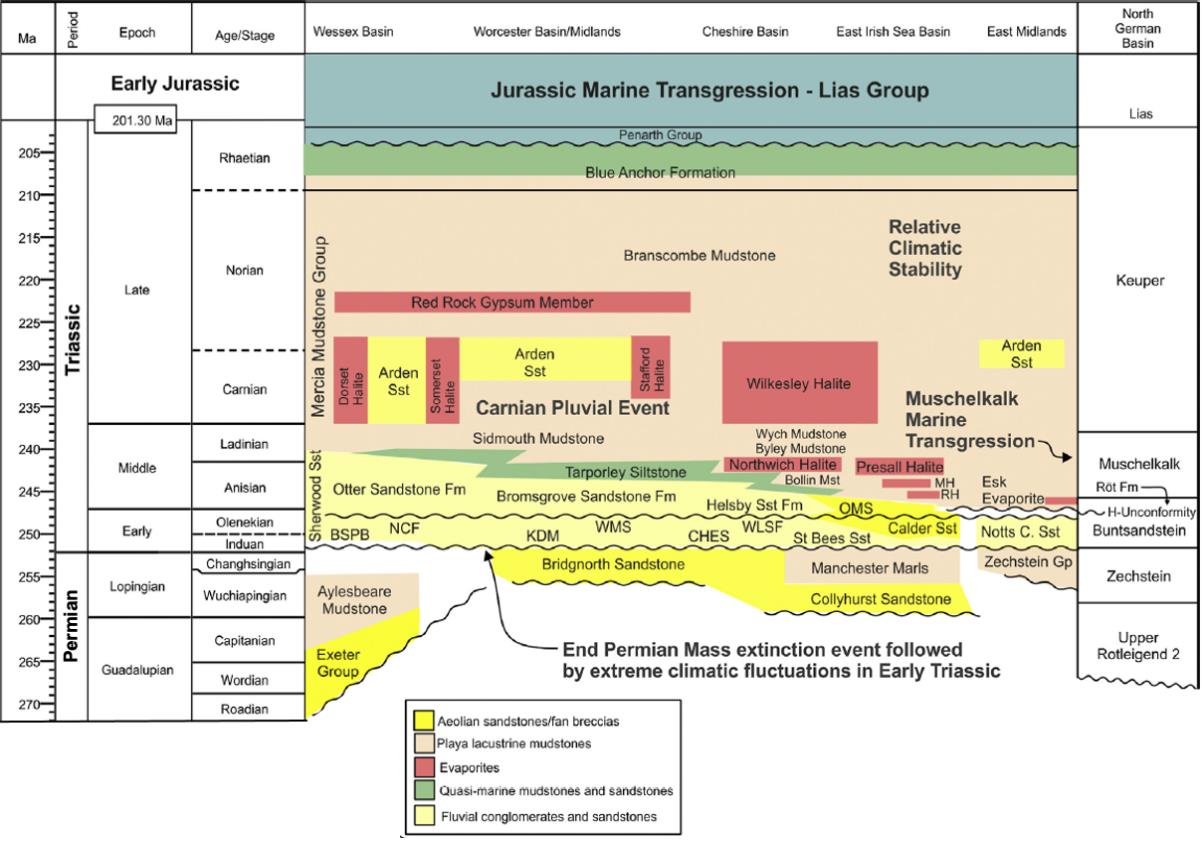
Figure 1. Triassic stratigraphy in a N-S section from the Wessex Basin, through the West Midlands, into the East Midlands, showing the occurrence of the Arden Sandstone (based on Newell, 2017).
A truly, local Warwickshire formation, it is named from its type section on the Grand Union Canal at Shrewley, that was first described by the Rev. Peter Bellinger Brodie, of Rowington, in 1856; and is now an SSSI. Indeed, the British Geological Survey reference sections are at Rowington (also on the Grand Union Canal), and in a cutting on Blackford Hill, SE of Henley-in-Arden. https://webapps.bgs.ac.uk/lexicon/lexicon.cfm?pub=AS. In fact, a similar thin sandstone sequence occurs across the Wessex Basin of southern Britain, through the Worcester Basin northwards into the West Midlands, then eastwards onto the East Midlands Shelf. A typical Arden Sandstone succession is up to 10m in thickness, and comprises thinly bedded, sharp-based, very fine to fine grained, rippled sandstones, which are overlain by thicker sets of cross-bedded sandstones that have high-energy plane beds. This upper unit has been widely used as a local building stone in Warwickshire, including in the construction of the fine St Peter’s Church in Wootton Wawen (and many other churches); and the National Trust medieval manor house at Baddesley Clinton.
The Rev. Brodie, vicar of Rowington from 1853 to 1897, and president of the Geological Society of London for 1894, found fossil fish and footprints of the reptile Rhynchosaurides from Shrewley and Rowington; whilst his son, Douglas Brodie, faithfully following in his fathers’ footsteps, described Chirotherium footprints (the famous ‘hand beast’) from near Preston Bagot (specifically ‘Whitley Green’), which is likely very close to the Blackford Hill exposure. Some of these rare fossil finds are on display in Warwick Museum, whilst examination of the Arden Sandstone, around Warwickshire, reveals abundant crustacean and worm burrows; desiccation cracks; common clam shrimp fossils of the genus Euestheria; plant remains; and small abraded remains of reptile bones (Figure 2).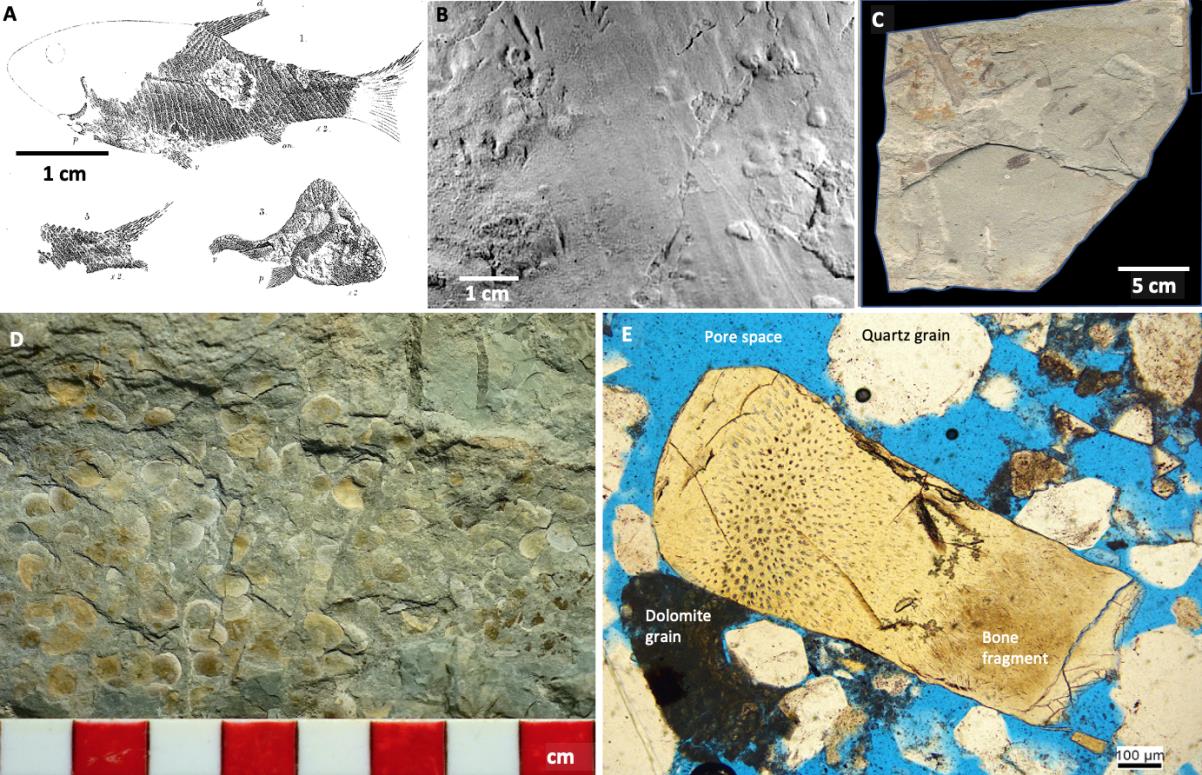
Figure 2. A. Drawings of Semionotus fossil fish discovered by Rev. Brodie in the Arden Sandstone at Shrewley. B. Rhynchosaurides tracks found by Brodie in the Arden Sandstone at Shrewley, now in Warwick Museum (from Radley, 2005). C. Horsetail fossil plant remains from the Arden Sandstone at Badgers Dell, Baddesley Clinton. D. Cluster of Euestheria clam shrimp shells from the Arden Sandstone at Blackford Hill road cutting, Henley-in-Arden. E. Thin section micrograph from the Arden Sandstone coarse bed, also at Henley-in-Arden. Blue colour is dyed epoxy used to make the thin section and represents pore space between grains. The large yellow coloured grain is a bone fragment, probably that of a reptile.
The red-coloured Mercia Mudstone Group mudstones represent the deposits of extensive, flat-lying, desert alluvial plains; similar to those of the modern Ranns of Kutch in western India. Dolomitic soils developed on these alluvial plains, and ephemeral lakes formed in the adjacent basin centres. Gypsum nodules were precipitated in the soils, and when the lakes dried out, evaporitic halite beds were deposited. Studies of Carnian deposits, worldwide, have identified this as a time of major global climatic and evolutionary change. The recognition of dramatically increased rainfall at this time, gave rise to the term ‘Carnian Pluvial Episode’ (Simms & Ruffell, 2018). In this context, the Arden Sandstone records progradation of the Mercia Mudstone Group inland lakes; and deposition of sandy, lake-margin deposits. These were locally fed by fast-flowing ephemeral rivers, as in ‘flash floods’, exemplified by the sequences exposed at Rowington and Inkberrow, which now record the deposits of small lake deltas, or terminal splays. Clam shrimps, known today, from ephemeral fresh-water ponds and lakes, fed on algal mats in the temporary ponds, and were in turn eaten by Triassic amphibians and reptiles, that wandered the lake shorelines. Fish thrived in the shallow lakes, and Crurotarsans, the precursors of crocodiles, ate the crustaceans and fish. At the beginning of the Carnian, 90% of tetrapods were Crurotarsans. Some 8 ma later, at the start of the Norian period, Dinosauria dominated the tetrapod population (Figure 3). The cause of this extreme variation in the Triassic climate is elusive, but many geologists consider the contemporary, extensive, volcanic eruptions in western North America, as the driver for late Triassic climate change. These volcanic eruptions resulted in huge amounts of CO2 being released into the late Triassic atmosphere, leading to increased rainfall, dramatic global warming, and rapid ocean acidification; thus turning a dry world, dominated by large deserts in the central part of the Pangaea super-continent, into a much more humid and wetter environment. Palaeontologists believe that the rapid diversification in the Dinosauria and related tetrapods, including turtles, crocodiles and lizards, was triggered by a major worldwide floral change that was directly associated with the Carnian Pluvial Episode. During this episode older floras, dominated by the seed-ferns, were replaced by conifers. So, on a pleasant sunny day, you can gently wander along the banks of the Grand Union Canal, to visit these important outcrops, trace the Rev. Brodie’s footsteps, imagine the torrential flooding of the Carnian desert, blooms of clam shrimps in ephemeral pools, and envisage the dawn of the dinosaurs, in the green sediments of the Arden Sandstone....
This presentation is hosted on YouTube
Mid December
Seasonal Social Meeting (not held this year)
Wednesday 12th January 2022
Dr Aaron Hunter (University of Cambridge)
The secret life of the starfish/crinoid
Asterozoans, including starfish and their close relatives the brittle stars, are amongst the most instantly recognisable and iconic marine animals. They are a dominant and successful group of living echinoderms based on their diversity, abundance, and global distribution. Despite their ecological success, and a fossil record spanning more than 480 million years, the early evolution of asterozoans remains a mystery. New discoveries,from France and Morocco, have begun to resolve this mystery. We look at the earliest, common ancestors of the ‘Bat star’ somasteroids, and their Cambrian descendants, including a new fossil from the exceptionally preserved Fezouata biota in Morocco, which is the earliest starfish-like animal so far recorded in the fossil record. We then follow these exceptional fossils, through the Ordovician, as true starfish and brittle stars appear; and show how they rapidly diversified during the biotic revolution we call the Great Ordovician Biodiversification Event.
Wednesday 19th January 2022
Dr Rob Vernon rtd. (Coal Board)
Mining on the Iberian Peninsula (WGCG)
The geology of the Iberian Peninsula provides a very diverse mining region. We look over the Spanish and Portuguese landscape, and into its mining history. The introduction will include a general overview of the geology; and the mining activity; followed by examples of specific mining areas, including the Iberian pyrite belt; mining activities in Andalusia, mentioning the activities of 19th century British companies; and the later activities of dredging companies.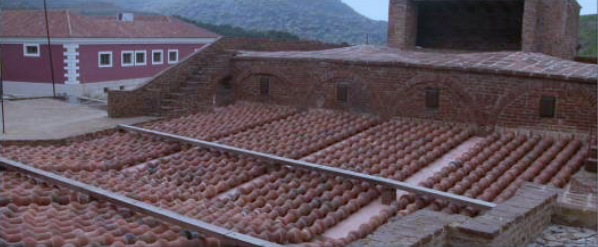
Mercury condenser - Almadén, Spain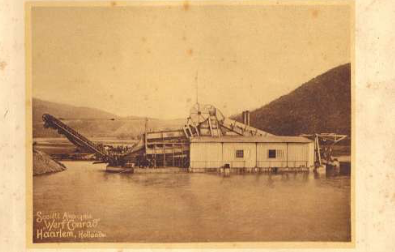
Gold Dredge - Northern Spain
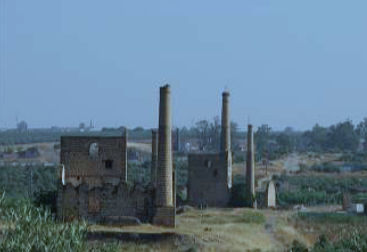
La Tortilla Lead Mine Linares Spain
This presentation is hosted on YouTube
Wednesday 9th February 2022
Dr Ben Clarke (University of Cambridge)
Don’t look down: the surprising similarities between volcanic eruptions and meteorite impact events in the rock record.
Meteorite impacts are some of the most energetic geological events in Earth history, but what would happen if Earth was struck tomorrow? Physicists and mineralogists have been studying these events for decades; and we have sophisticated numerical models that predict the consequences. But do their assertions hold-water? As part of the meteorite impact research group here at the University of Leicester, my colleagues and I study the rocks left behind by these catastrophic events. As a group, we have a background in volcanology, studying some of the largest volcanic eruptions in the geological record, and we have found some remarkable similarities between the two phenomena. We take a whistle-stop-tour through the geology of meteorite impacts, reaching the frontier of our understanding (perhaps sooner than you might think!). We can then explore what volcanoes might be able to tell us about some of the most consequential, Earth-shattering, events in the history of our planet, and life upon it.
Wednesday 16th February 2022
Dr Simon Drake (Research Associate, Birkbeck University of London)
The Kilchrist Caldera, Isle of Skye, Scotland (WGCG)
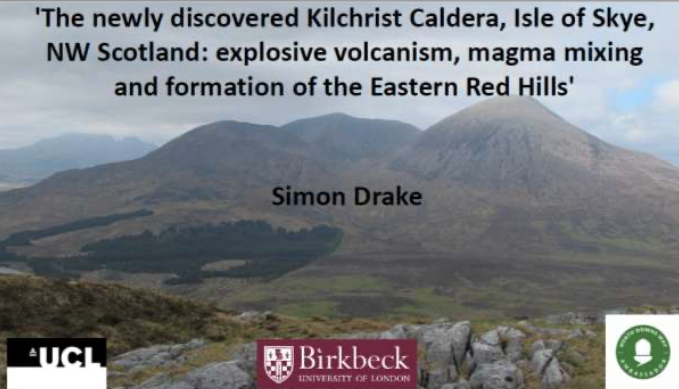
Highly silicic Paleocene-Eocene ignimbrite deposits, and mafic lavas at Kilchrist and Belig, Isle of Skye, NW Scotland, form part of a ~800m thick extensive caldera-fill which largely fringes the Eastern Red Hills on Skye. Magma was supplied to the growing caldera via the Moine-related Kishorn Thrust fault, and ponded against pre-existing Paleocene rocks of the Cuillin, and Western Red Hills Centres. Silicic magma reservoirs, which fed the Kilchrist Caldera, were frequently replenished with basic magma. Such replenishment triggered eruptions. Later eruptions typically deposited extremely coarse ignimbrites, demonstrating catastrophic collapse of the caldera. Collapse was followed by caldera resurgence, and formation of the Eastern Red Hills Granite Centre.
Within the caldera sequence, ignimbrites at Kilchrist have been dated at 56.15 Ma. This date is precisely coincident with the Paleocene-Eocene Thermal Maximum (PETM). We suggest that the increases of the North Atlantic atmospheric temperature, during the PETM, were intimately linked to the consumption of surrounding dolostone country-rock by the Kilchrist caldera. We calculate such consumption released between ~5.32 - 8.52 Gt of CO2 into the Paleocene atmosphere. Our study provides the first unequivocal evidence [of the effect that] large-scale eruptions within the North Atlantic Igneous Province [had] on the PETM.
This presentation is hosted on YouTube
https://youtu.be/iql2eUh9ET4
Thursday 24th February
Dr Aaron Hunter (University of Cambridge)
The secret life of the starfish/crinoid
A repeat of his excellent presentation given 12th January
Asterozoans including starfish and their close relatives, the brittle stars, are amongst the most instantly recognisable and iconic marine animals. They are a dominant and successful group of living echinoderms based on their diversity, abundance, and global distribution. Despite their ecological success, and a fossil record spanning more than 480 million years, the early evolution of asterozoans remains a mystery. New discoveries, from France and Morocco, have begun to resolve this mystery. We look at the earliest common ancestors of the ‘Bat star’ somasteroids and their Cambrian descendants, including a new fossil from the exceptionally preserved Fezouata biota in Morocco, which is the earliest starfish like animal so far recorded in the fossil record. We then follow these exceptional fossils through the Ordovician as true starfish and brittle stars appear, and show how they rapidly diversified during the biotic revolution we call the Great Ordovician Biodiversification Event
Wednesday 9th March 2022
A hybrid meeting - both hosted in Zoom, and in reality, on campus at Leicester University
Dr Mark Evans (British Antarctic Survey)
The Rutland Dinosaur - A giant ichthyosaur from Rutland: Britain’s largest “sea dragon”, from England’s smallest county
In early 2021 some large fossil vertebrae were found protruding from the mud beside a lagoon at Rutland Water Nature Reserve. An initial site visit confirmed that they belonged to a large ichthyosaur – fish-shaped marine reptiles from the Mesozoic. An initial dig revealed that the specimen was complete from the skull to the end of the tail. At approximately 10 metres in length, it is the largest complete skeleton of an ichthyosaur, or any other fossil reptile, ever found in Britain. Its geological setting is the Whitby Mudstone Formation, which largely underlies Rutland Water, and it is therefore approximately 180 million years old (Toarcian, Early Jurassic).
This talk describes the subsequent full excavation, and lifting, of the specimen, over a period of approximately three weeks, in late summer 2021. Preliminary observations indicated the ichthyosaur is a member of the genus Temnodontosaurus, and probably the species T. trigonodon, which has not been recorded with certainty from Britain before. Although there remains much research to be done, following the eventual cleaning and conservation of the skeleton, I will discuss its wider context and significance.
Wednesday 16th March 2022
Emeritus Professor Alex Maltman (Aberystwyth University)
Wine Whisky & Beer - the rôle of geology (WGCG)
We read that the taste of wine is affected by the geology of the vineyard, and that whisky is influenced by the rocks the water encountered on its way to the distillery. With beer, on the other hand, geology is rarely mentioned.
This talk explores this contrasting situation, to reach, perhaps, surprising conclusions. The talk may even prompt you to think about your favourite tipples in a new light!
Wednesday 30th March 2022
AGM (Zoom)
Monday 4th April 2022
A joint presentation to the Parent Body of the Leicester Literary and Philosophical Society and to Section C - Geology
Held in the New Walk Museum and Art Gallery, Leicester
Professor Dame Jane Francis DCMG FRS (Director, British Antarctic Survey).
From Greenhouse to Icehouse; from Forests to Frosts; Antartica's Climate History
Antarctica is a frozen, white, world of ice and snow, in a remote region of our planet. Despite its remoteness, it has a profound impact on global climates and sea level, that affect us all today, and into the future.
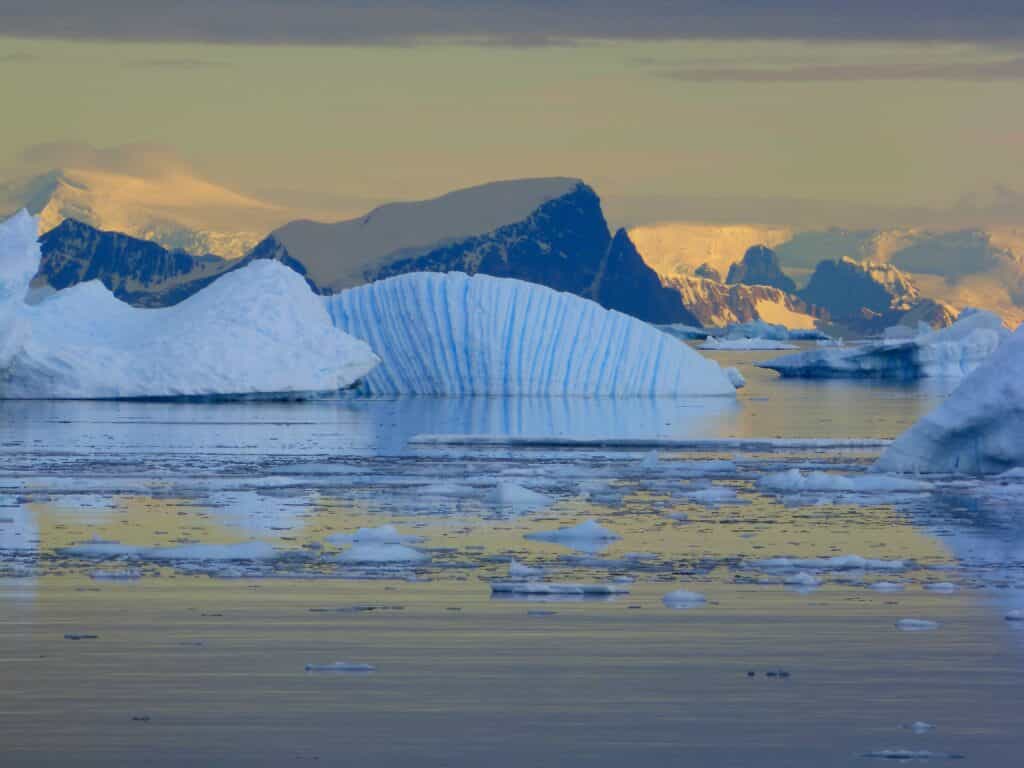
Antarctica is a frozen white world of ice and snow in a remote region of our planet. Despite its remoteness, it has a profound impact on global climates and sea level that affect us all today.
About 100 million years ago, however, Antarctica was not white but green, even though the continent was situated over the South Pole. The climate was warmed naturally by carbon dioxide from volcanic eruptions, allowing dinosaurs to live in lush polar forests that spread from Patagonia, across Antarctica, to Australia.
The plants in those forests can now be found, as fossils, in exposed rocks amid the ice sheets of Antarctica. The fossils of wood, leaves, pollen, and even flowers, show that the vegetation consisted of trees and shrubs that were the ancestors of the modern Southern Hemisphere vegetation. Forty million years ago, Antarctica turned from green to white, as the greenhouse climate cooled, ice sheets formed across the South Pole, and the continent became the icehouse that we see today. Now, scientists see evidence of warming climates, and melting ice sheets, in Antarctica. The fossilised plants may thus provide us with a window into life at high latitudes in our future warm world.
Wednesday 20th April 2022
Ekbal Hussain (British Geological Survey)
A recipe for disaster (WGCG)
In recent decades, globally, two thirds of deaths arising from nature, were caused by geological hazards. But how, and why, do natural hazards turn into disasters? I will explore this question through the lens of one particularly troublesome hazard: earthquakes. The death toll for a given earthquake magnitude (and mechanism), will depend on geographic location, the social vulnerability of communities, and the quality of the building stock. This talk compares and contrasts global trends in earthquake fatalities, and aims to extract common themes that exacerbate the impact of natural hazards, and consider where and why these turn into disasters.